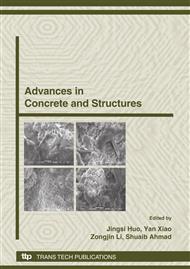p.169
p.175
p.181
p.187
p.195
p.203
p.211
p.215
p.221
Preparation and Performance of Sulfate Resistance Cement-Based Material
Abstract:
To discuss prevention of sulfate attack, especially thaumasite form of sulfate attack (TSA), sulfate resistance cement based material (SRM) were designed and prepared, and properties of which were investigated systematically. Micro-analytical techniques were introduced to identify erosion substances especially thaumasite, namely Fourier transform infrared spectroscopy (FTIR), X-ray diffraction (XRD), scanning electron microscope (SEM) equipped with X-ray energy dispersive spectrometer(EDS). Results show that SRM have better sulfate resistance, as well as TSA resistance, when exposed to aggressive environment with 33800 ppm mass concentration of SO42- in magnesium sulfate solution at 5°C±2°C. When immersed in magnesium sulfate solution for 40 weeks, compressive strength and tensile strength of SRM are still higher than their initial, and those of control specimen are lower by 33.7%, 36.5% compared to its initial. Surface erosion substances of SRM named S1 are ettringite and gypsum, while those of control specimen are ettringite, gypsum, thaumasite and brucite.
Info:
Periodical:
Pages:
195-201
Citation:
Online since:
October 2008
Authors:
Price:
Сopyright:
© 2009 Trans Tech Publications Ltd. All Rights Reserved
Share:
Citation:


